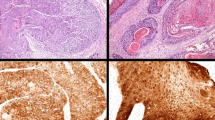Abstract
Human papillomaviruses (HPV) have been detected in squamous cell carcinoma (SCC) of the aerodigestive tract with varying frequency of 10%-100% mainly due to detection methods and primer pairs used. Polymerase chain reaction (PCR) is the most sensitive and Southern blot hybridization (SBH) the most specific detection method of HPV DNA. Both methods achieve the most reliable results. 22 SCC DNA samples of the hypopharynx were analyzed by type specific and consensus primer PCR and Southern blot analysis. HPV was detected in 5/22 (22.6%) hypopharyngeal SCC specimens. HPV 18 and HPV 45 were identified in one case each. An HPV prevalence of 23% is a realistic approximation in hypopharyngeal SCC. The high rate of HPV positive only detected by non type specific detection methods indicates the presence of previously undescribed HPV types.
Similar content being viewed by others
References
Baay, M.F.D.; Quint, W.G.V; Koudstaal, J.; et al. (1996): Comprehensive study of several general and type-specific primer pairs for detection of human papillomavirus DNA by PCR in paraffin-embedded cervical carcinomas. Hournal of Clinical Microbiology 34 : 745–747.
Brandwein, M.S.; Biller, H.; Nuovo, G. J. (1993): Analysis of prevalence of human papillomavirus in laryngeal carcinomas. Ann Otol Rhinol Laryngol 102 : 309–313.
Chang, F. (1990): Human papillomavirus (HPV) in the pathogenesis of squamous cell carcinoma: morphological and DNA-hybridization studies on carcinomas of cervix, oral mucosa and esophagus. University of Kuopio, Alkuperistutkimusket 6 : 1–93.
Erlich, H.A.; Gclfand, D.; Sninsky, J.J. (1991): Recent advances in the polymerase chain reaction. Science 253 : 1643- 1651.
Guerrero, E.; Daniel, R.W.; Bosch, F.X. et al. (1992): Comparison of Vira Pap, Southern hybridization, and polymerase chain reaction methods for human papillomavirus identification in an epidemiological investigation of cervical cancer, Journal of Clinical Microbiology 30 : 2951–2959.
Hoffmann, M.; Mahnke, C.G.; Goeroegh, T. et al (1996): Human papillomavirus DNA sequences in squamous cell carcinoma of the head and neck. In : Head and Neck Cancer-Advances in Basic Research. Edts : Werner, J.A.; Lippert, B.M.; Ruderi. H.H. Elsevier Science, Netherlands, pp : 369–378.
Hoffmann, M.; Kahn, T.; Mahnke, C.G. et al. (1977) :Prevalence of human papillomavirus in squamous cell carcinoma of the head and neck determined by polymerase chain reaction and Southern blot hybridization: Proposal for opitimized diagnostic requirements. Acta Otolaryngologica (Stockholm) : in press.
IARC, International agency for research on cancer monograps on the evaluation of carcinogenic risks to humans (1995). Vol.64. Human papillomaviruses. Lyon, France.
Jalal, H.; Snaders, C.M.; Prime, S.S. et al. (1992): Detection of human papillomavirus type 16 DNA in oral squames from normal young adults. Journal of Oral Pathology and Medicine 21 : 465–470.
Manos, M.M.; Ting, Y.; Wright. D.K. (1989): The use of polymerase chain reaction amplification for the detection of genital human papillomaviruses. In : Cancer cells 7/Molecular Diagnostics of human cancer. New York : Cold Spring Harbour, pp209–214.
Shamanin, V., Glover, M.; Rausch, C et al. (1994): Specific types of human papillomavirus found in benign proliferations and carcinomas of the skin in immunosuppressed patients. Cancer Research 54 : 4610–4613.
Shimada, M.; Fukushima, M.; Mukai, H. et al. (1990): Amplification and specific detection of transforming gene region of human papillomavirus 16, 18 and 33 in cervical carcinoma by means of the polymerase chain reaction. Japanese Journal of Cancer Research 81: 1–5.
Snijders, P.J.F.; van den Brule, H.J.F.; Schreijnemakers, H.F. et al. (1900): The use of general primers in the polymerase chain reaction permits the detection of a broad spectrum of human papillomavirus genotypes, Journal of Gen Virology 71 : 173–181.
Snijders, P.J.F.; Scholes, A.G.M.; Hart, C.A. et al. (1996): Prevalence of mucsotropic human papillomaviruses in squamouscell carcinomas of the head and neck. International Journal of Cancer 66 : 464–469.
Van den Brule, A.J.C.; Claas, E.C.I.; du Maine, M. et al. (1989): Use of anticontamination primers in the polymerase chain reaction for the detection of human papillomavirus genotypes in cervical scrapes and biopsies. Journal of Medical Virology 29: 20–27.
Zur Hansen, H.; de Villiers, E.M. (1994): Human Papillomaviruses. Annu Rev Microbiol 48 : 427–447.
Author information
Authors and Affiliations
Rights and permissions
About this article
Cite this article
Hoffmann, M., Folz, B.J., Niemann, A.M. et al. Human papillomaviruses in hypopharyngeal squamous cell carcinoma. IJO & HNS 50, 233–240 (1998). https://doi.org/10.1007/BF03006998
Published:
Issue Date:
DOI: https://doi.org/10.1007/BF03006998



